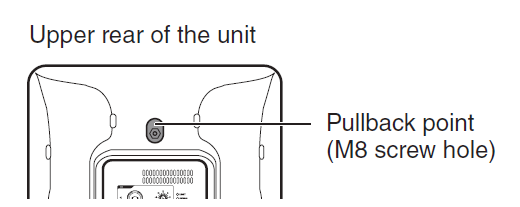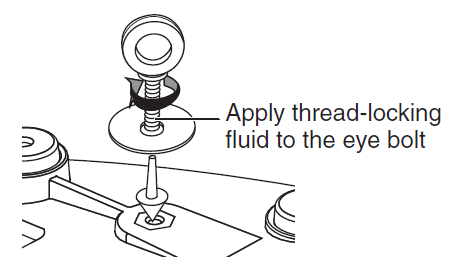
Yamaha DBR Series DBR15 Powered Speaker
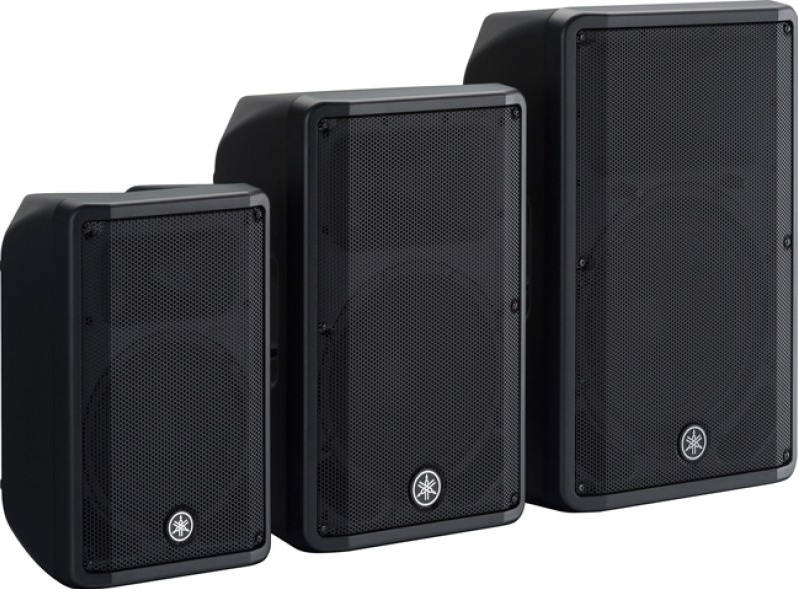
To take full advantage of the DBR series’ (referred to in this manual as DBR) superior functionality and enjoy years of trouble-free use, please read this manual before you begin using the product. After you have read the manual, keep it in a safe place for reference when needed.
- Please read the PRECAUTIONS on the reverse side of this manual before use.
- This manual uses example illustrations taken from the DBR12, unless otherwise specified.
- The illustrations as shown in this manual are for instructional purposes only and may appear somewhat different from those on your device.
- The company names and product names used in this manual are the trademarks or registered trademarks of their respective companies.
Features
- FIR-X tuning™
Our proprietary sound-processing technology, utilizing a linear-phase FIR filter delivers excellent sound quality with high resolution and a smooth frequency response that is unaffected by phase interference near the crossover point. - D-CONTOUR (Dynamic CONTOUR)
D-CONTOUR optimizes the level of each frequency range according to the application to be used or the listener’s preferences. There are two modes: an FOH/MAIN mode for use as a main speaker, and a MONITOR mode for use as a floor monitor. - Simple mixing function
The DBR features simple mixing functionality, enabling you to select either a direct output of channel 1 (CH1) (parallel connection) or a mixed output of CH1 and CH2. - Various input/output connectors
The comprehensive set of connectors—including XLR for a mixer, phone for a musical instrument, and RCA plug for an MP3 player—provides maximum flexibility in use with a wide variety of applications. - Lightweight, high power
A newly developed power supply and amplifier have enabled compact size and light weight, as well as powerful output. - Advanced protection functionality
DSP-controlled advanced protection functionality promotes optimum reliability even in challenging environments.
Included Accessories
- AC power cord
- Technical Specifications (English only): includes specifications, block diagram, and dimensions.
- Owner’s manual (this leaflet)
Controls and Connectors
Rear

Bottom
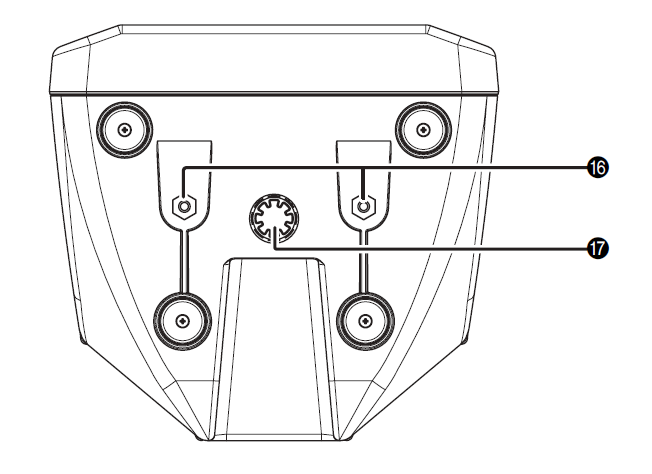
- Input jacks (CH1 and CH2)
These are balanced combo jacks that support both XLR and phone plugs (for both CH1 and CH2), as well as RCA pin plugs (for CH2 only). For the combo jacks, connect a mixer, microphone, or digital musical instrument such as a keyboard. For RCA pin jacks, connect a device such as an MP3 player or a CD player. For devices with high-level signals, such as a mixer, connect to CH2, or connect to CH1, then set the [MIC/LINE] switch (3) to [LINE]. - [LEVEL] knobs
Adjust the level of each input jack (1). - [MIC/LINE] switch
Set this switch to [MIC] or [LINE] for the CH1 jack, depending on the level of the input signal. For low-level signals (such as microphones), set the switch to [MIC]. For high-level signals (such as mixer), set the switch to [LINE].
- Output switch
Selects the output signal sent to the output jack (5).- [CH1 THRU]: Delivers the direct output signal of CH1 only. The signal from CH2 will not be output.
- [CH1+2 MIX]: Outputs the mixed signals of CH1 and CH2.
- Output jack
This is a balanced XLR jack. This can be used to connect another DBR speaker. Outputs the signal selected by the 4-output switch. - [LIMIT] indicator
Indicates (lit in red) that the limiter is on when the output voltage of the amplifier has exceeded the maximum level, or when excessive integral power consumption is detected. If this indicator stays lit, lower the input level.
Note: Integral power consumption refers to the sum of power provided to the speaker driver per unit time. - [SIGNAL] indicator
Indicates (lit in green) when an audio signal exceeding the threshold has been detected. - [PROTECTION] indicator
Indicates (lit in red) when the protection circuit is active. The protection circuit will be activated and the speaker outputs will be muted in the situations listed below.- If amplifier overheating is detected
- If an overcurrent is detected
When turning the power on, the protection circuit will be activated for a few seconds to prevent noise. The indicator turns off when the power supply has started normally. If the protection circuit has engaged, waiting until the amplifier cools down or powering off and on again will return to normal operation. If the unit does not return to normal operation, please contact your Yamaha dealer.
- [POWER] indicator
Indicates (lit in green) when the power switch is turned on.
power switch is turned on. - [D-CONTOUR] indicator
Indicates (lit in yellow) when the [D-CONTOUR] switch (A) is set to [FOH/MAIN] or [MONITOR]. - [D-CONTOUR] switch
Selects one of the D-CONTOUR (Dynamic CONTOUR) presets.- [FOH/MAIN]: Boosts the high and low frequency components so that the frequency response is suitable for a main speaker.
- [MONITOR]: Reduces the low frequency range, which could otherwise tend to be boomy if the speaker is set directly on the floor. This enables you to hear mid and high frequency ranges clearly when using as a floor monitor.
- [OFF]: Turns off D-CONTOUR. This is a generic frequency response setting.
- [HPF] switch
Selects the cutoff frequency of the high-pass filter. If you set this switch to [120Hz] or [100Hz], the low-frequency components below each threshold will be cut. If you use the unit alone, set this switch to [OFF]. If you plan to use the unit along with a subwoofer, we recommend that you set this switch to [120Hz] or [100Hz]. - Vent
The unit contains a cooling fan. Since the air for cooling is taken in and expelled here, be careful not to block this vent. - [AC IN] socket
Connect the supplied power cord here. First, connect the power cord to the unit, then plug it into an appropriate AC power outlet.
CAUTION: Turn off the power before you connect or disconnect the power cord.  (power) switch
(power) switch
Turns power to the unit on [|] or off. First, turn on the power of the connected sound source (external device), then the unit. When turning off the power, reverse the order by turning off the power of the unit first and then the connected sound source (external device).
CAUTION
Even when the switch is in the off position, a small amount of electricity is still flowing to the unit. If it will not be used for an extended period of time, therefore, be sure to unplug the power cord from the wall AC outlet.
Note- Rapidly turning the unit on and off in succession can cause it to malfunction. After turning the unit off, wait for
about 5 seconds before turning it on again. - If you are using multiple units, turn on the power to each unit one by one. If you turn on the power to multiple units simultaneously, a temporary drop in the power voltage may occur, possibly resulting in abnormal operation of the units.
- Rapidly turning the unit on and off in succession can cause it to malfunction. After turning the unit off, wait for
- Screw holes (M8)
Use these M8 size screw holes for installing separately sold brackets or commercially available eye bolts. - Pole socket
This socket adapts to commercially available speaker stands and speaker poles of 35 mm diameter.
Setup Examples
Simple system with a single DBR
This example illustrates the system when connecting directly to a microphone, musical instrument, or background music source without using a mixer. Main application: small-sized live venue, presentations, restaurants
Note: For CH2, inputs to the combo jack and to the RCA pin jacks will be mono mixed at a fixed balance. If you want to change the balance, adjust the volume of the connected sound source.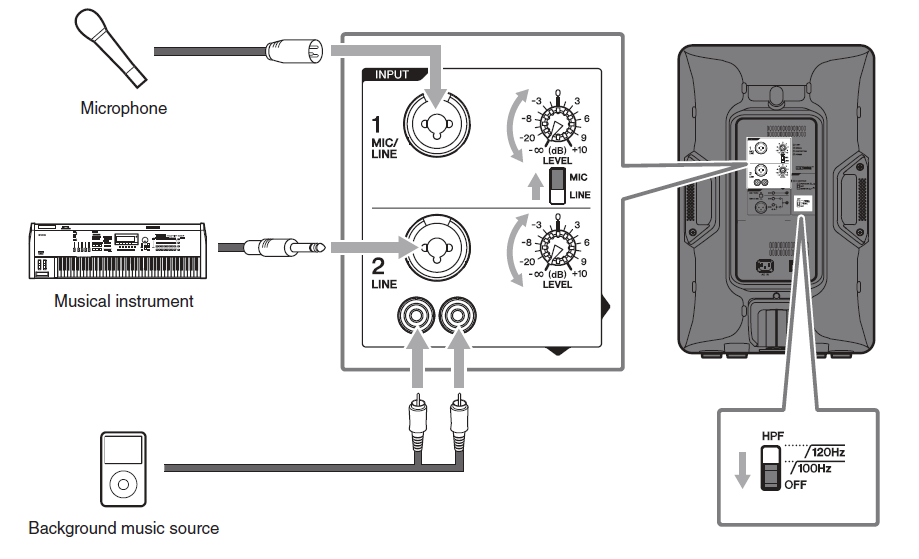
System with two DBRs and subwoofers
This system is the most suitable for a main speaker system. If desired, you can add another DBR to create
a floor monitor system. Main application: small-sized live venue, house of worship, event site
Note: We recommend using the Yamaha DXS series (referred to in this manual as DXS) as a subwoofer. In this case, we recommend that the DBR’s HPF cutoff frequency and the DXS’s LPF cutoff frequency are set to the same settings; however, you can adjust it as desired.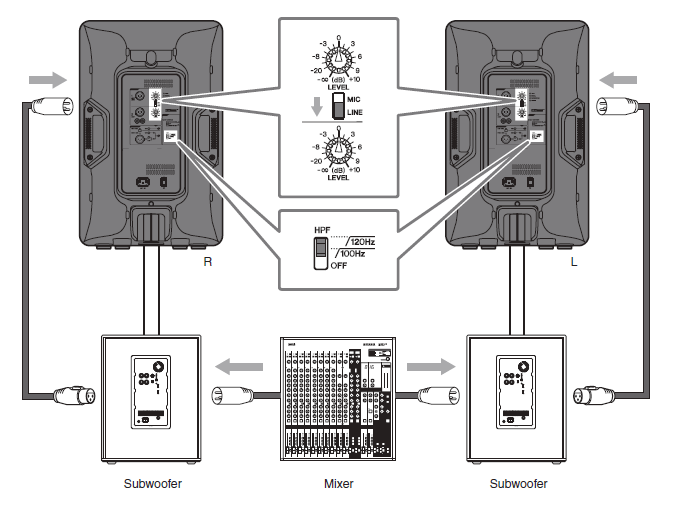
Floor monitor system
This system is suitable for a performer’s monitoring system. For use as a vocal monitor, set the [D-CONTOUR] switch to [MONITOR]. If necessary, you can additionally connect up to four speakers in parallel. In this case, we recommend that the signal is input to CH1 and the output switch is set to [CH1 THRU].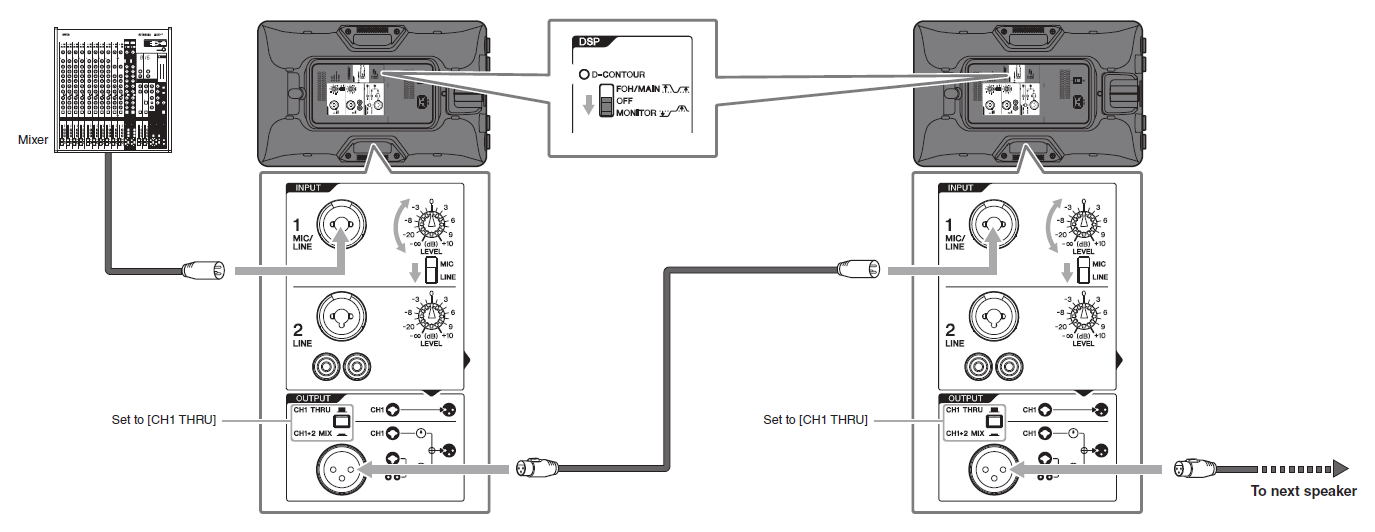
Troubleshooting

If any specific problem should persist, however, please contact your Yamaha dealer.
Installation
CAUTION
- Before doing any installation or construction work, consult with your Yamaha dealer.
- For optimum safety, the installation should be checked thoroughly at regular intervals. Some fittings may deteriorate over extended periods due to wear and/or corrosion.
- When choosing the installation location, suspension wire, and mounting hardware, make sure all are strong enough to support the weight of the speaker.
- Make sure to take measures to prevent the speaker from falling down in the event of an installation failure.
- When installing the safety wire to the wall, install it higher than the wire’s attachment point on the speaker, with as little slack as possible. If the wire is too long, and the speaker happens to fall, the wire may snap as a result of too much
strain.
Yamaha cannot be held responsible for damage or injury caused by the insufficient strength of the support structure or improper installation.
Installation using a separately sold Yamaha speaker bracket
Attach the bracket to two screw holes at the bottom of the unit using commercially available screws (M8 x 16 mm) or eye bolts (M8 x 15 mm). For details on installing the bracket, refer to the corresponding manual.
Using the BWS251-300 or BWS251-400 wall mounting bracket
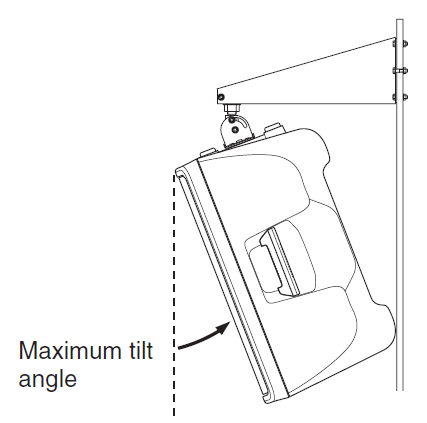
The tilt angle depends on the position relation between the speaker and the wall. The maximum downward tilt angle is shown in the following chart.
Using the BCS251 ceiling bracket
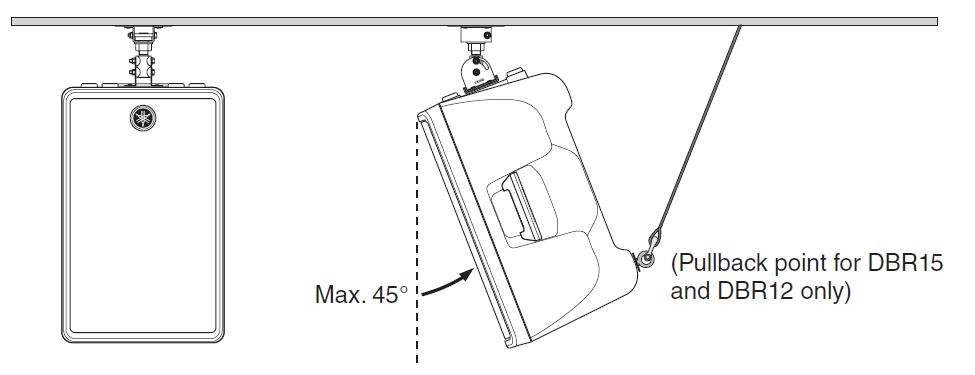
Using the BBS251 baton bracket
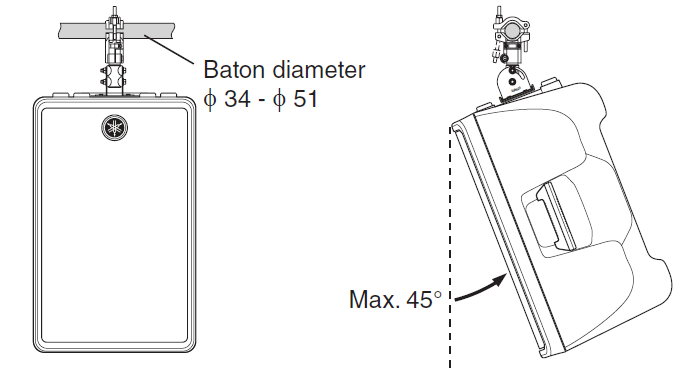
Note: To prevent the unit from falling, attach the safety wire as shown in the illustration.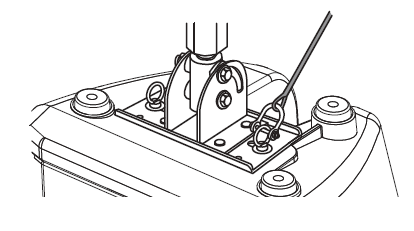
Pullback point (only for DBR15 and DBR12)
- When the unit is shipped from the factory, a seal is stuck on the pullback point (screw hole). Make sure to peel off the seal when using the pullback point.
- The DBR10 does not have a pullback point.

Securing the screws and eye bolts
- Insert the screw or eye bolt through the washer to attach them.

Installation using eye bolts
Attach commercially-available eye bolts (M8 x 15 mm) to the screw holes located at the bottom (two locations) and on the upper rear (one location, only for DBR15 and DBR12). Keep in mind that you will need two points at the bottom to suspend the unit.
Note: Make sure to use eye bolts according to the standards and safety regulations in your area.
NOTICE
The strength of an eye bolt differs depending on the suspension angle. Make sure to use eye bolts within an angle of 0 to 45 degrees from a right angle (as shown).
Correct: Within 45° of a right angle
Incorrect: Do not suspend the eye bolts as shown in the illustrations below.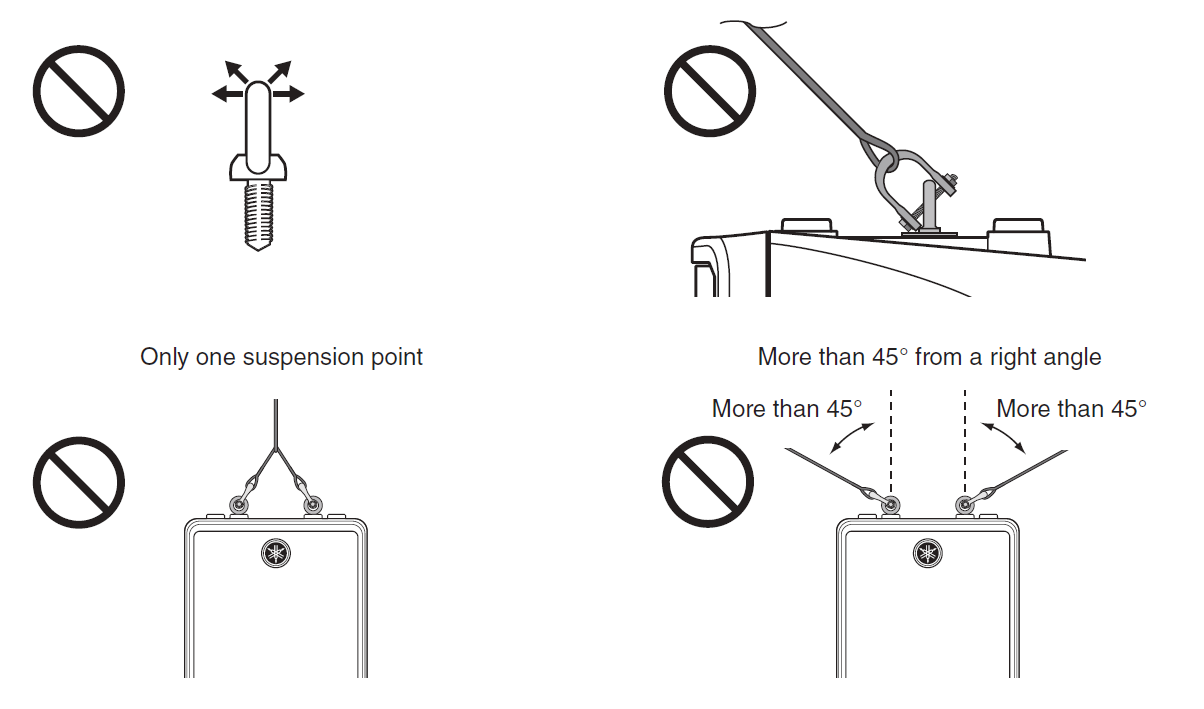
General Specifications
Specifications and descriptions in this owner’s manual are for information purposes only. Yamaha Corp. reserves the right to change or modify products or specifications at any time without prior notice. Since specifications, equipment or options may not be the same in every locale, please check with your Yamaha dealer.
Information for Users on Collection and Disposal of Old Equipment
This symbol on the products, packaging, and/or accompanying documents means that used electrical and electronic products should not be mixed with general household waste. For proper treatment, recovery and recycling of old products, please take them to applicable collection points, in accordance with your national legislation and the Directives 2002/96/EC. By disposing of these products correctly, you will help to save valuable resources and prevent any potential negative effects on human health and the environment which could otherwise arise from inappropriate waste handling. For more information about the collection and recycling of old products, please contact your local municipality, your waste disposal service, or the point of sale where you purchased the items.
[For business users in the European Union]
If you wish to discard electrical and electronic equipment, please contact your dealer or supplier for further information.
[Information on Disposal in other Countries outside the European Union]
This symbol is only valid in the European Union. If you wish to discard these items, please contact your local authorities or dealer and ask for the correct method of disposal.
PRECAUTIONS
PLEASE READ CAREFULLY BEFORE PROCEEDING
Please keep this manual in a safe place for future reference.
WARNING
Always follow the basic precautions listed below to avoid the possibility of serious injury or even death from electrical shock, short-circuiting, damage, fire or other hazards. These precautions include, but are not limited to, the following:
Power supply/power cord
- Do not place the power cord near heat sources such as heaters or radiators, and do not excessively bend or otherwise damage the cord, place heavy objects on it, or place it in a position where anyone could walk on, trip over, or roll anything over it.
- Only use the voltage specified as correct for the device. The required voltage is printed on the nameplate of the device.
- Use only the supplied power cord/plug.
- Check the electric plug periodically and remove any dirt or dust that may have accumulated on it.
- Be sure to connect to an appropriate outlet with a protective grounding connection. Improper grounding can result in electrical shock, damage to the device(s), or even fire.
Do not open
- This device contains no user-serviceable parts. Do not open the device or attempt to disassemble the internal parts or modify them in any way. If it should appear to be malfunctioning, discontinue use immediately and have it inspected by qualified Yamaha service personnel.
Water warning
- Do not expose the device to rain, use it near water or in damp or wet conditions, or place on it any containers (such as vases, bottles or glasses) containing liquids which might spill into any openings. If any liquid such as water seeps into the device, turn off the power immediately and unplug the power cord from the AC outlet. Then have the device inspected by qualified Yamaha service personnel.
- Never insert or remove an electric plug with wet hands.
Fire warning
- Do not put burning items, such as candles, on the unit. A burning item may fall over and cause a fire. If you notice any abnormality
- When one of the following problems occurs, immediately turn off the power switch and disconnect the electric plug from the outlet. Then have the device inspected by Yamaha service personnel.
- The power cord or plug becomes frayed or damaged.
- It emits unusual smells or smoke.
- Some object has been dropped into the device.
- There is a sudden loss of sound during use of the device.
- If this device should be dropped or damaged, immediately turn off the power switch, disconnect the electric plug from the outlet, and have the device inspected by qualified Yamaha service personnel.
CAUTION
Always follow the basic precautions listed below to avoid the possibility of physical injury to you or others, or damage to the device or other property. These precautions include, but are not limited to, the following:
Power supply/power cord
- When removing the electric plug from the device or an outlet, always hold the plug itself and not the cord. Pulling by the cord can damage it.
- Remove the electric plug from the outlet when the device is not to be used for extended periods of time, or during electrical storms.
Location
- Do not place the device in an unstable position where it might accidentally fall over.
- Do not block the vents. This device has ventilation holes at the rear to prevent the internal temperature from becoming too high. In particular, do not place the device on its side or upside down. Inadequate ventilation can result in overheating, possibly causing damage to the device(s), or even fire.
- When installing the device:
- Do not cover it with any cloth.
- Do not install it on a carpet or rug.
- Do not use the device in a confined, poorly-ventilated location.
Inadequate ventilation can result in overheating, possibly causing damage to the device(s), or even fire. Make sure that there is adequate space around the device: at least 30cm above, 30cm at the sides and 30cm behind.
- Do not use the speaker’s handles for suspended installation. Doing so can result in damage or injury.
- Do not hold the bottom of the device when transporting or moving it. In doing so, you may pinch your hands under the device, which and result in injury.
- Do not press the rear panel of the device against the wall. Doing so may cause the plug to come in contact with the wall and detach from the power cord, resulting in short circuiting, malfunction, or even fire.
- Do not place the device in a location where it may come into contact with corrosive gases or salt air. Doing so may result in malfunction.
- Before moving the device, remove all connected cables.
- When setting up the device, make sure that the AC outlet you are using is easily accessible. If some trouble or malfunction occurs, immediately turn off the power switch and disconnect the plug from the outlet. Even when the power switch is turned off, electricity is still flowing to the product at a minimum level. When you are not using the product for a long time, make sure to unplug the power cord from the wall AC outlet.
- Always consult qualified Yamaha service personnel if the device installation requires construction work, and make sure to observe the following precautions.
- Choose mounting hardware and an installation location that can support the weight of the device.
- Avoid locations that are exposed to constant vibration.
- Use the required tools to install the device.
- Inspect the device periodically.
Connections
- Before connecting the device to other devices, turn off the power for all devices. Before turning the power on or off for all devices, set all volume levels to minimum.
Maintenance
- Remove the power plug from the AC outlet when cleaning the device.
Handling caution
- Do not insert your fingers or hands in any gaps or openings on the device (vents, etc.).
- Avoid inserting or dropping foreign objects (paper, plastic, metal, etc.) into any gaps or openings on the device (vents, etc.) If this happens, turn off the power immediately and unplug the power cord from the AC outlet. Then have the device inspected by qualified Yamaha service personnel.
- Do not rest your weight on the device or place heavy objects on it, and avoid use excessive force on the buttons, switches or connectors.
- Do not use the device for a long period of time at a high or uncomfortable volume level, since this can cause permanent hearing loss. If you experience any hearing loss or ringing in the ears, consult a physician.
- Do not operate the device if the sound is distorting. Prolonged use in this condition could cause overheating and result in fire.
- Do not pull the cables connected to the microphones, etc. Yamaha cannot be held responsible for damage caused by improper use or modifications to the device, or data that is lost or destroyed.
For more manuals by Yamaha, visit ManualsLibraryy
Yamaha DBR Series DBR15 Powered Speaker-FAQs
What is the frequency response of the Yamaha DBR15?
The Yamaha DBR15 has a frequency response of 50 Hz to 20 kHz (-10 dB), delivering a wide range of sound. It also features a crossover frequency of 2.1 kHz and a 90° coverage angle, ensuring clear and even sound distribution.
What is the frequency response of the DBR10 model?
The Yamaha DBR10 offers a frequency range of 55 Hz to 20 kHz (-10 dB), making it ideal for smaller setups while still providing excellent clarity.
Is the Yamaha DBR12 a good speaker?
Yes, the DBR12 is praised for its excellent sound quality and value. It’s especially well-suited for vocals and live band performances, with plenty of headroom and clarity for various audio needs.
What is the warranty period for the Yamaha DBR15?
The DBR15 comes with a standard 5-year warranty, with an option to extend it by 2 additional years when you register your product on Yamaha’s website, totaling 7 years of coverage.
What is Yamaha’s Tactile Response System (TRS)?
The Tactile Response System replicates the feel of traditional acoustic instruments by transmitting string vibrations through the keys and offering pedal resistance based on depth—enhancing the realism in Yamaha digital pianos.
How many watts does a 15-inch speaker typically use?
A 15-inch speaker like the DBR15 typically ranges between 250W and 550W, depending on usage. The DBR15 features a high-efficiency amplifier rated at 1000W (peak) for powerful, reliable performance.
How much does the Yamaha Silent Bass weigh?
The Yamaha Silent Bass weighs approximately 6.8 kg (15 lbs), making it lightweight and portable for performers.
What does frequency response mean in speakers?
Frequency response describes how accurately a speaker can reproduce sound across a range of frequencies. It shows the speaker’s ability to handle both low and high tones without distortion or loss of quality.



